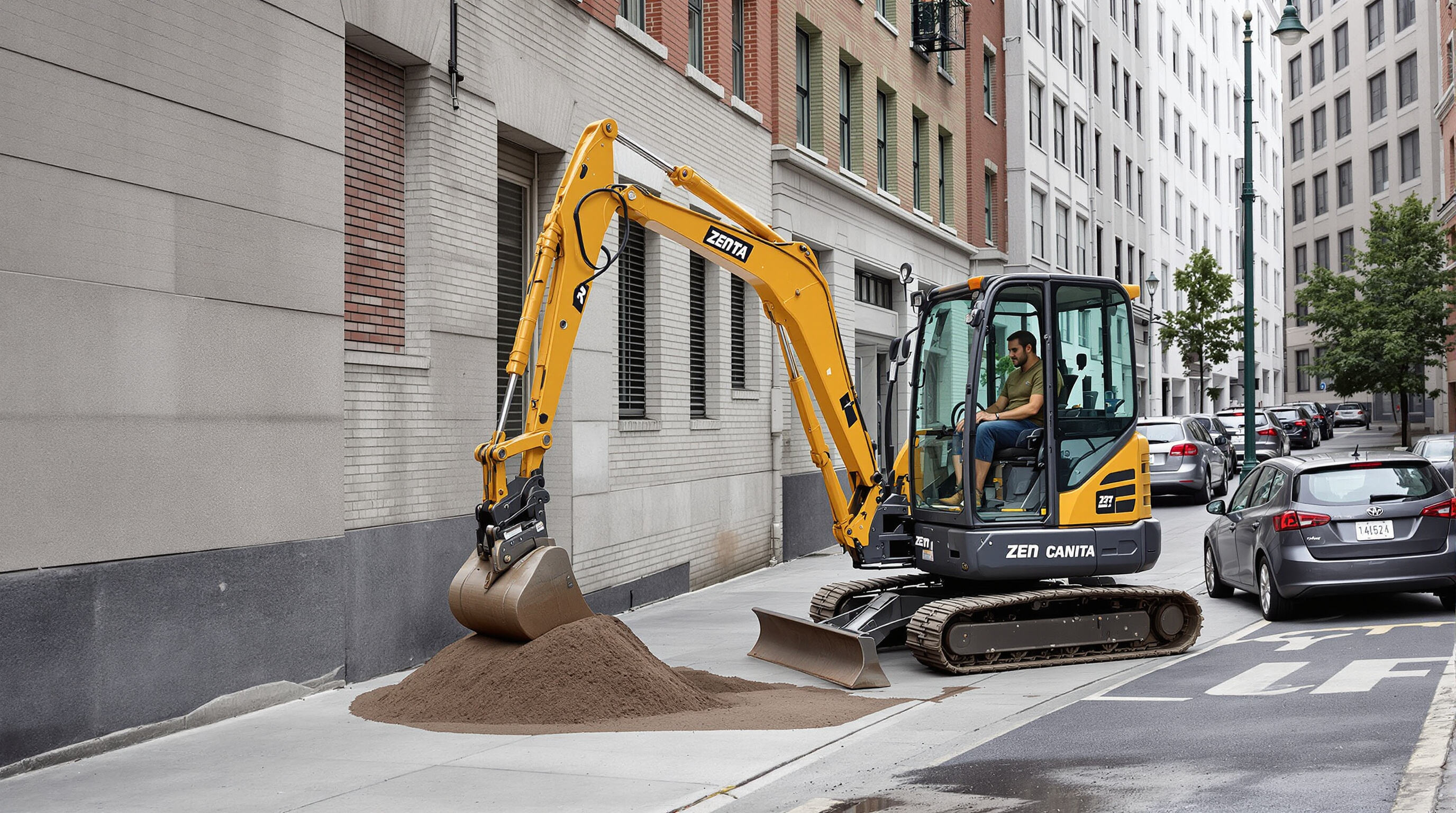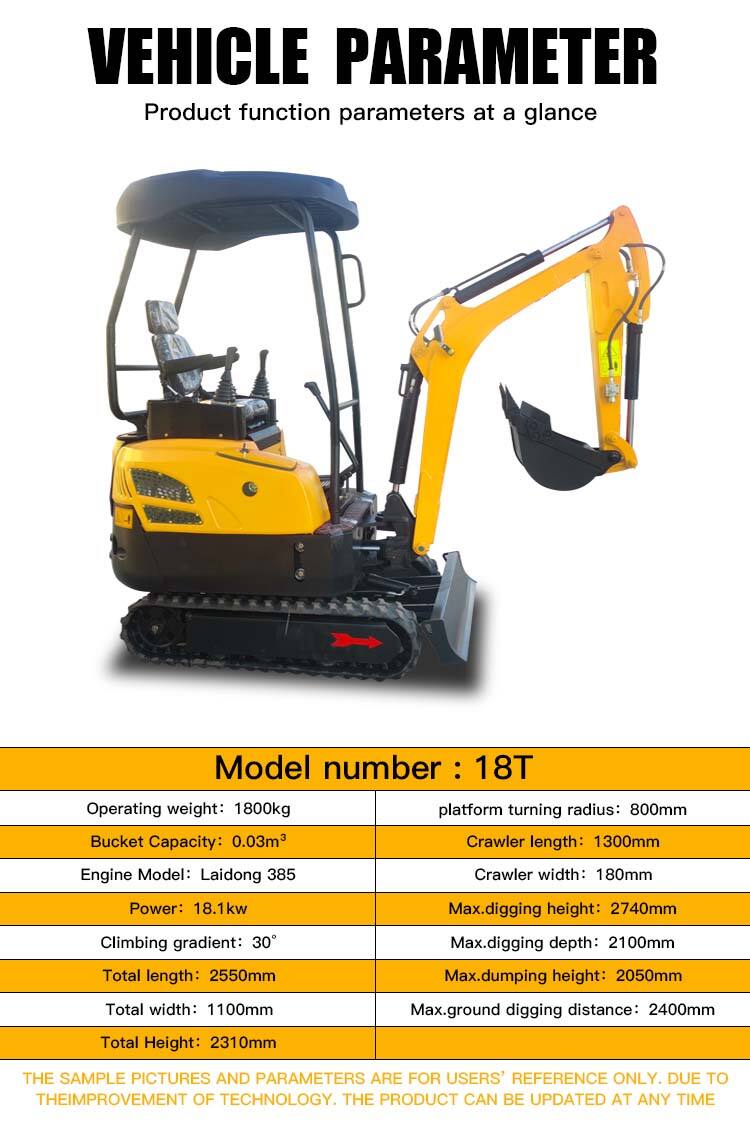Why the Mini Excavator Excels in Compact and Urban Workspaces

Understanding the Core Design Advantages of the Mini Excavator
In city settings, mini excavators have become indispensable thanks to their specialized design. These machines typically weigh less than six tons and can work right on pavement and sidewalks without leaving marks behind. Their hydraulic systems pack quite a punch too, delivering around 80 to 90 percent of what bigger machines offer in terms of digging power. Some models feature zero tail swing designs that get rid of that annoying rear overhang problem. This means operators can rotate all the way around within the space the machine actually occupies. Pretty important stuff when there are buildings close by or sensitive underground lines to avoid damaging during excavation work.
| Design Feature | Urban Workspace Benefit | Traditional Excavator Limitation |
|---|---|---|
| Compact dimensions | Fits through 36" gates | Requires 8'+ clearance |
| 12-15 PSI ground pressure | Preserves paved surfaces | 30+ PSI risks asphalt damage |
| Zero tail swing | Safe rotation in alleys under 10' wide | 48"+ rear swing radius creates hazards |
How Compact Size Enhances Maneuverability in Tight Urban Spaces
Mini excavators are just 5 feet wide, so they can squeeze through tight spots between cars that are parked, scaffolding setups, and those pesky utility poles that block so many worksites. These smaller machines actually get stuck less often than compact track loaders do in similar situations. The track-on-tire design makes them really mobile too. Workers can drive them from one job site to another without needing special transport trucks or trailers for hauling. Some recent studies looking at city construction efficiency back this up. In busy downtown areas where space is at a premium, crews finish their work about 25 percent quicker when using these mini machines instead of going with the big, bulky equipment typically seen on larger sites.
The Role of Zero Tail Swing in Improving Job Site Safety and Efficiency
According to the Construction Safety Institute from 2024, zero tail swing machines cut down on worksite accidents by about 63% when working in tight spaces. These machines don't require workers to keep moving them back and forth near people walking by or close to property lines. The way these machines are built lets crews dig trenches right next to buildings without stopping, and they can place materials super close to things that might get in the way. This really matters during renovations in old neighborhoods where getting measurements just right down to the millimeter helps avoid wrecking historic structures. Contractors working on these projects appreciate how much this feature saves them from potential headaches later on.
Landscaping Made Efficient: Key Applications of the Mini Excavator
Trenching, Grading, and Shaping Terrain With Precision
Mini excavators offer really precise control when working on landscaping jobs, especially good for digging trenches for those 8 to 24 inch utility lines and getting slopes graded just right within half an inch accuracy. These machines typically have between 6 and 10 kilonewtons of digging power, which lets them take out material exactly where needed without messing up nearby patios or flower beds something that matters a lot when doing terraces or drainage swales. According to Landscape Management from last year, folks who operate these machines say preparation time gets cut down by about 35% compared to doing everything manually. Plus there's no problem with compacted soil around delicate tree roots like there often is with bigger equipment.
Efficient Planting and Tree Transplantation Using Augers and Buckets
Quick-attach augers drill 18"-diameter tree holes in 90 seconds, while 16"-wide grading buckets lift 300 lb root balls intact. This versatility allows crews to transplant mature shrubs 60% faster than traditional methods, minimizing transplant shock. A single mini excavator handles the full cycle—from donor site excavation to backfilling around relocated specimens.
Streamlining Irrigation System Installation With Targeted Digging
Mini excavators simplify complex irrigation installations by:
- Digging 12"-deep trenches around established trees without harming surface roots
- Boring under concrete walkways using narrow trenching buckets
- Precisely backfilling to protect PVC pipes from soil shifts
Proportional hydraulic controls enable millimeter-perfect trenching near existing utilities, reducing installation errors by 42% compared to backhoes (Irrigation Association 2024).
Case Study: Residential Backyard Transformation
A 0.3-acre property was transformed from overgrown thicket to a multi-zone entertainment space in 40 operational hours using a 1.8-ton mini excavator. The project highlighted the machine's ability to outperform manual labor while preserving existing vegetation.
| Task | Traditional Method | Mini Excavator Time |
|---|---|---|
| Stump Removal | 2 days (manual) | 3.5 hours |
| Retaining Wall Base | 1 week (hand digging) | 8 hours |
| Koi Pond Excavation | Not feasible | 6 hours |
Precision Demolition: How Mini Excavators Master Confined-Space Teardowns
Mini Excavator Demolition Capabilities in Urban and Residential Zones
Small excavators are great for knocking down stuff where big machines just can't fit. A recent survey from construction equipment folks found that city contractors finish jobs about 42 percent quicker when they use these little diggers for specific demolition work. We're talking machines weighing between 2.5 and 5 tons here. They squeeze into tight spots like narrow alleys and backyard gates, yet still pack enough punch to take apart concrete slabs and old brick walls. Contractors love them for jobs in crowded urban areas where bigger equipment would be impossible to maneuver.
Achieving Efficiency and Precision in Demolition With Hydraulic Breakers
Fitted with 700—1,200 ft-lb hydraulic breakers, mini excavators break reinforced concrete with surgical accuracy. Where manual crews require 3—5 days to demolish a single-family garage, mini excavators complete the task in 8—12 hours and reduce injury risks by 68% (OSHA 2022).
Reducing Collateral Damage Using Compact Excavator Versatility and Attachments
Rubber tracks and zero-tail-swing designs allow operation within 6 inches of standing structures. Operators use trenching buckets for foundation removal, grapples for rebar sorting, and crushers for on-site recycling—all without compromising adjacent buildings.
Trend Analysis: Rising Adoption of Mini Excavators in Interior Structure Teardowns
Demand for 360-degree rotating compact excavators rose 31% from 2020 to 2023 as contractors increasingly use them for indoor renovations. Their ability to ascend temporary ramps and operate in basements makes them ideal for floor-to-ceiling demolition in multi-story residential buildings.
Expanding Capabilities: Versatile Attachments That Boost Mini Excavator Performance

Common Attachments for Mini Excavators (e.g., Buckets, Augers, Grapples)
Attachment versatility is the primary reason 85% of contractors choose mini excavators (Equipment World 2024). Key tools include:
- Standard buckets for precise digging and trenching
- Hydraulic augers capable of drilling 24" diameter holes in compact soils
- Grapples that handle debris removal with 360° rotation
- Tiltrotators providing ±45° tilt for complex grading
A 2024 study found that mini excavators equipped with multi-attachment systems reduced project completion times by 34% compared to single-function models (LinkedIn 2024).
The Impact of Quick Couplers on Switching Between Versatile Attachments
Hydraulic quick couplers enable attachment changes in under 90 seconds from inside the cab, cutting idle time by 70% during multi-phase jobs while meeting ISO 13031-2017 safety standards. Modern couplers feature automatic pressure relief, visual lock confirmation, and universal mounting plates compatible with over 90% of available attachments.
Hydraulic Attachments in Construction and Demolition: Enhancing Productivity
Auxiliary hydraulic systems deliver up to 28 GPM flow, powering high-performance tools:
| Attachment Type | Force Output | Common Applications |
|---|---|---|
| Hydraulic Breaker | 1,200-1,800 ft-lbs | Concrete slab demolition |
| Plate Compactor | 6,500-8,500 lbs | Soil compaction |
| Rotary Cutters | 360° continuous rotation | Vegetation management |
These attachments enable 40% faster material processing than manual methods and significantly reduce operator fatigue (Journal of Construction Engineering 2024).
Innovation Spotlight: Multi-Function Grapples and Tilt Rotators From Shandong Hessne
Leading manufacturers now integrate AI-assisted systems that automatically adjust hydraulic pressure and cycle times based on material density. Innovations include:
- Smart Grapples with 0.5-ton load sensors
- Tiltrotators offering 10 programmable digging patterns
- Hybrid Attachments combining drilling and compaction
Field tests show these technologies increase attachment utilization by 55% on mixed-material job sites.
Controversy Analysis: Are Universal Quick Couplers Compromising Safety for Convenience?
Quick couplers certified by ISO standards can cut down changeover times by around 80%, according to industry benchmarks. But looking at recent OSHA reports for 2024 shows something troubling: nearly one in five equipment failures actually stemmed from problems with how things were connected improperly. Industry professionals have been arguing about this for years, focusing mainly on three key areas: getting everyone to follow the same standards, making sure those mechanical locks really work when needed, and ensuring different models play nicely together hydraulically. The latest rules coming out under ANSI/SAIA A92.24-2024 mandate that every single coupler must have a backup locking system. This does add roughly 15% extra time to the coupling process, but it dramatically cuts down on failures too - manufacturers claim risk drops by almost 93%. Most plant managers I've talked to see this as worth the tradeoff despite the added minutes.
Mini Excavator Advantages Across Industries: Beyond Landscaping and Demolition
Mini Excavator Applications in Landscaping vs. Full-Sized Models
Mini excavators outperform full-sized models in residential and precision landscaping due to their 35—50% smaller footprint (Construction Machinery Journal 2023). While larger machines excel at bulk earthmoving, compact units allow precise trenching, intricate grading near structures, and zero-turn maneuverability to protect mature trees.
Compact Excavator Versatility in Utility Work and Road Maintenance
Municipal crews use mini excavators for underground repairs and asphalt patching in busy urban corridors. Articulating 180° booms and rubber tracks minimize traffic disruption during waterline or storm drain work. Grading blades and hydraulic augers streamline road shoulder repairs and signpost installations.
Emerging Uses in Agriculture and Snow Removal
Farmers deploy mini excavators for orchard root pruning, livestock trench drainage, and silage bunker maintenance—tasks once requiring multiple specialized machines. Winter teams attach snow pushers or melt-system plows to clear narrow pathways and parking structures. This adaptability has driven a 22% year-over-year increase in agricultural-sector rentals (Equipment Rental Association 2024).
Leading manufacturers continue expanding attachment ecosystems, ensuring these compact machines meet evolving demands across industries without sacrificing efficiency.
FAQ
Why are mini excavators preferred in urban workspaces?
Mini excavators are preferred in urban spaces due to their compact size, ability to work without damaging paved surfaces, and zero tail swing design which allows for safe operation in tight areas.
How do mini excavators improve efficiency in landscaping?
Mini excavators offer precise control for trenching, grading, and shaping terrain. They also facilitate quick tree transplantation and streamline irrigation installations with targeted digging.
Can mini excavators be used for demolition?
Yes, mini excavators are highly effective in confined-space demolitions due to their ability to deliver surgical precision with hydraulic breakers, reduce injury risks, and work within close proximity to structures.
What attachments enhance the performance of mini excavators?
Attachments like buckets, augers, grapples, and tiltrotators significantly enhance the versatility and efficiency of mini excavators by allowing them to perform various tasks quickly and with precision.
What are the considerations around quick couplers for mini excavators?
Quick couplers facilitate quick attachment changes, but safety concerns have prompted standards that require backup locking systems to prevent equipment failures, adding time but increasing safety.
Table of Contents
- Why the Mini Excavator Excels in Compact and Urban Workspaces
- Landscaping Made Efficient: Key Applications of the Mini Excavator
-
Precision Demolition: How Mini Excavators Master Confined-Space Teardowns
- Mini Excavator Demolition Capabilities in Urban and Residential Zones
- Achieving Efficiency and Precision in Demolition With Hydraulic Breakers
- Reducing Collateral Damage Using Compact Excavator Versatility and Attachments
- Trend Analysis: Rising Adoption of Mini Excavators in Interior Structure Teardowns
-
Expanding Capabilities: Versatile Attachments That Boost Mini Excavator Performance
- Common Attachments for Mini Excavators (e.g., Buckets, Augers, Grapples)
- The Impact of Quick Couplers on Switching Between Versatile Attachments
- Hydraulic Attachments in Construction and Demolition: Enhancing Productivity
- Innovation Spotlight: Multi-Function Grapples and Tilt Rotators From Shandong Hessne
- Controversy Analysis: Are Universal Quick Couplers Compromising Safety for Convenience?
- Mini Excavator Advantages Across Industries: Beyond Landscaping and Demolition
- FAQ

